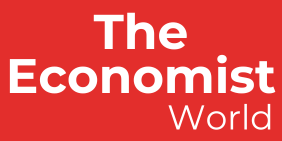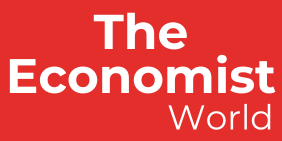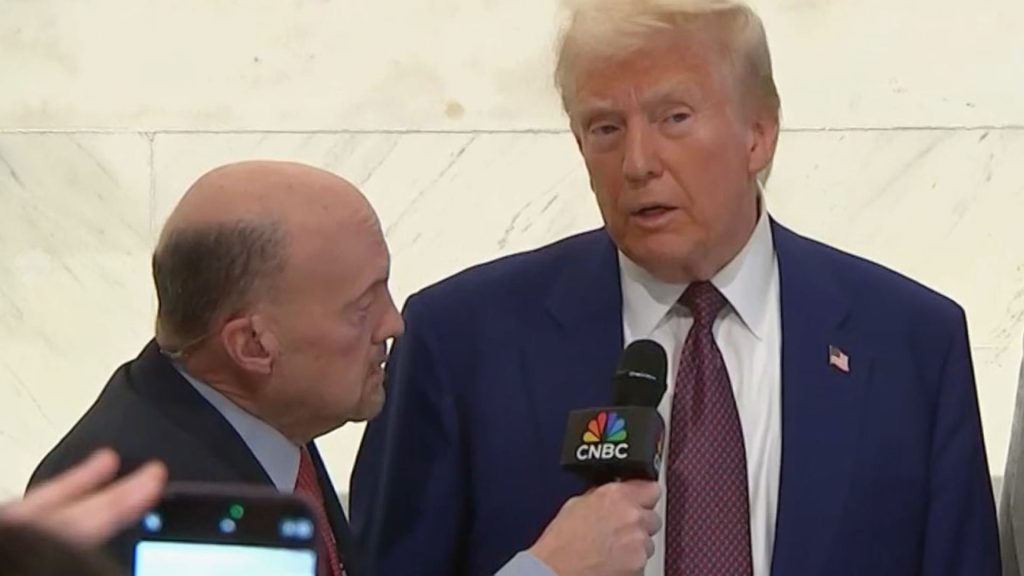Post Views: 67
“If you wanted to make the market crash, I think you would go with this game plan.” That’s what Jim Cramer said Friday morning , and it sums up last week’s President Donald Trump -induced destruction of the stock market with sweeping global tariffs. The S & P 500 , which sank back into correction territory Thursday, closed Friday ever closer to falling into a bear market — now down roughly 17.5% from its Feb. 19 record close. The Nasdaq went into a bear market Friday — now down almost 23% from its Dec. 16 all-time closing high. Corrections are measured by declines of 10% or more from recent highs. Bear markets are defined as declines of 20% or more from recent highs. Jim also said Friday, “It should not be in our country’s interest to have the market crash.” The S & P 500 had a stunning two-day loss of more than 10.5% after the president announced his new tariffs after this past Wednesday’s close on Wall Street. Trump tried to talk the market up on social media Friday, saying his plans will make everyone rich. He also jawboned the Federal Reserve, arguing Fed Chairman Jerome Powell should cut interest rates now . In a prepared speech, Powell said he sees tariffs raising inflation, and the central bank should continue to wait before making any more rate moves. The market clearly thinks it’s time to move on rates, with the CME FedWatch tool showing at least four cuts this year. The Fed’s next scheduled monetary policy meeting is set for May. Central bankers held rates steady in January and March after cutting them three times at the end of last year. In the rubble of Thursday and Friday’s market, there were two possible bright spots: plummeting oil prices and sinking bond yields. Both of these trends support the case that it just might be OK for the Fed to cut rates without rekindling inflation. West Texas Intermediate crude sank another 7.4% Friday to under $62 per barrel, breaking a three-week winning streak. We know that cheaper oil means cheaper gas, which means consumers get relief on one of their major daily costs. That bodes well for the inflation picture, which also went in the right direction on wages in March. Friday’s jobs report also showed nonfarm payrolls growth was stronger. Cooler-than-expected wage growth and stronger-than-expected job additions help tamp down worries about stagflation. Lower bond yields — which saw the 10-year Treasury last week hit 3.86%, its lowest since October — can provide relief on consumer loans. In fact, mortgage rates follow the 10-year, which should help bring rates on benchmark 30-year fixed-rate mortgages down toward 6.5%. History has shown that home loan rates at that level and below tend to spur housing activity, which has been stalled for quite some time. Those possible green shoots kept Club name Home Depot steady during Friday’s ugly session while homebuilder stocks such as Lennar and Toll Brothers soared. Jim sees Home Depot as a buying opportunity . In last week’s trades, the potential tariff impact on GE Healthcare was a bridge too far since the medical equipment giant has so much manufacturing overseas. We exited the position on Friday. We did, however, buy some more Eaton and Texas Roadhouse in Thursday’s market decline. We started the week by exiting Alphabet on concerns that artificial intelligence models encroaching on Google Search will only get worse. The week ahead will feature the start of earnings season, specifically two Club financials, and more data on the economy, including two readings on inflation. The twists and turns of the Trump tariff story will be pivotal for the markets, too. Tariffs Trump’s steeper tariffs are set to kick in on Wednesday, April 9. That would be a few days after his 10% near-universal tariff on imports to the U.S. went into effect as scheduled on Saturday. The big question is whether Trump will budge on any of the duty rates — such as 20% on the European Union; 27% on India; 26% on South Korea; and 46% on Vietnam — before Wednesday rolls around. The president followed up his Friday comments with a social media post on Saturday, saying: “Hang tough, it won’t be easy, but the end result will be historic.” In general, the country-specific tariffs were much more aggressive than anyone on Wall Street expected, so, in theory, there’s plenty of room to negotiate them down, which the equity markets would greet with open arms. However, there’s been some mixed messaging out of the White House on the possibility of negotiations, adding to the uncertainty and volatility. In a commentary Friday, Jeff Marks, director of portfolio analysis for the Club, pointed out that Trump’s willingness to talk to Vietnam about a tariff deal is a good sign for the market. “But, we still need to see how Europe responds, especially after China announced retaliatory tariffs and measures targeting a few U.S. companies,” he wrote. Economy We’ll get the government’s consumer price index on Thursday and the producer price index on Friday — collectively, they’ll provide a look at the prices paid by consumers on a range of goods and services in March, as well as an update on wholesale inflation, which measures what producers are paid for their output; that’s why the PPI is usually seen as a leading indicator of consumer inflation. If businesses are seeing their costs rise on inputs such as steel or corn to feed livestock, it could eventually translate to higher prices for consumers — or, if companies eat the higher costs, lower profits. Economists expect the CPI to rise 2.6% on an annual basis in March and 0.2% month over month, according to FactSet. Core CPI, which excludes volatile food and energy prices, is projected to show a 3% annual increase and 0.3% on a monthly basis. The headline increase on PPI is expected to be 3.1% year over year and 0.1% month over month, according to FactSet. Excluding food and energy, core PPI is seen coming in up 3.5% annually and 0.3% monthly. At the same time, the main discussion around inflation at this point is not really what happened in March, but what will happen in the months ahead if Trump’s steep and broad tariffs are enacted as promised. The duties are widely expected to push up inflation gauges in the short run, with more uncertainty around the long-term ramifications. “If implemented, the effective US tariff rate will likely approach a 25% rate,” economic analysts at JPMorgan wrote in a note to clients Thursday, adding: “The impact on inflation will be substantial, adding close to 2% to the CPI this year (assuming only limited business margin compression).” Put another way, the inflation reports on Thursday and Friday still matter, but the tariff developments inject a ton of uncertainty into what those reports will look like going forward, so the data needs to be interpreted within that context. While the market is expecting lots of rate cuts this year, the Fed could be in a real jam if inflation remains stickier than expected in this week’s data and beyond. Earnings First-quarter earnings season is set to begin in earnest Friday when a group of major banks and financials report their January-to-March results. Club names Wells Fargo and BlackRock are among them. The reports come against the backdrop of growing economic concerns, which is usually a bad thing for bank stocks. The group was crushed on Thursday and then again on Friday. The conference calls for Wells Fargo and BlackRock — and, frankly, all companies reporting coming up — are going to take on even greater importance than usual because the world looks so much different than it did during the quarters that are about to be reported. It’s difficult to imagine any management teams will want to strike an upbeat tone with their commentaries and outlooks, given the widespread uncertainty. Still, hearing from Wells Fargo executives on the economy and what they’re seeing with consumers will still be valuable. Similarly, with BlackRock, CEO Larry Fink certainly has his finger on the pulse of the business community — arguably as much as anybody — so getting his updated view on the economy and markets following Trump’s tariff announcement will be valuable. There are a few company-specific metrics to watch out for, in addition to the usual revenue and earnings per share figures. For Wells Fargo, that includes net interest income, expense growth and provisions for loan losses, which is a tangible way of measuring how banks are protecting against a possible worsening in economic conditions. Any color management can provide on its quest to get its Fed-imposed asset cap removed would be welcome. For BlackRock, the big three metrics are net inflows during the quarter, assets under management and fee growth. We’re also hoping to get a progress report from Fink and CFO Martin Small on its recent acquisitions — Global Infrastructure Partners last year and Preqin in late February — and updates on other pending deals, including a plan to buy port operations near the Panama Canal. Fink released his annual shareholders’ letter last week and talked up those deals . As of Friday, Wells Fargo is expected to report first-quarter earnings per share of $1.24 on revenues of $20.79 billion, according to LSEG. BlackRock is projected to have earned $10.48 per share on revenues of $4.73 billion, according to LSEG. Week ahead Monday, April 7 After the close: Levi Strauss & Co. (LEVI), Dave & Buster’s Entertainment (PLAY), Greenbrier Companies (GBX) Tuesday, April 8 NFIB Small Business Index at 6 a.m. ET Before the bell: Tilray (TLRY), Walgreens Boots Alliance (WBA), RPM International (RPM), WD-40 C. (WDFC) After the close: Cal-Maine Foods (CALM) Wednesday, April 9 Wholesale inventories at 10 a.m. ET Federal Reserve policy meeting minutes at 2 p.m. ET Before the bell: Delta Air Lines (DAL), Simply Good Foods (SMPL), Neogen Corp. (NEOG), After the close: Constellation Brands (STZ), PriceSmart (PSMT) Thursday, April 10 March consumer price index at 8:30 a.m. ET Initial jobless claims at 8:30 a.m. ET Before the bell: CarMax (KMX), Lovesac Company (LOVE) Friday, April 11 March producer price index at 8:30 a.m. ET University of Michigan consumer sentiment index at 10 a.m. ET Before the bell: JPMorgan Chase (JPM), BlackRock (BLK), Wells Fargo (WFC), Bank of New York Mellon (BK), Morgan Stanley (MS), Fastenal Co. (FAST) After the close: The Children’s Place (PLCE) (See here for a full list of the stocks in (Jim Cramer’s Charitable Trust.) As a subscriber to the CNBC Investing Club with Jim Cramer, you will receive a trade alert before Jim makes a trade. Jim waits 45 minutes after sending a trade alert before buying or selling a stock in his charitable trust’s portfolio. If Jim has talked about a stock on CNBC TV, he waits 72 hours after issuing the trade alert before executing the trade. THE ABOVE INVESTING CLUB INFORMATION IS SUBJECT TO OUR TERMS AND CONDITIONS AND PRIVACY POLICY , TOGETHER WITH OUR DISCLAIMER . NO FIDUCIARY OBLIGATION OR DUTY EXISTS, OR IS CREATED, BY VIRTUE OF YOUR RECEIPT OF ANY INFORMATION PROVIDED IN CONNECTION WITH THE INVESTING CLUB. NO SPECIFIC OUTCOME OR PROFIT IS GUARANTEED.
U.S. President Donald Trump disembarks Air Force One as he arrives at Miami International Airport in Miami, Florida, U.S., April 3, 2025.
Kent Nishimura | Reuters
“If you wanted to make the market crash, I think you would go with this game plan.”
That’s what Jim Cramer said Friday morning, and it sums up last week’s President Donald Trump-induced destruction of the stock market with sweeping global tariffs.


